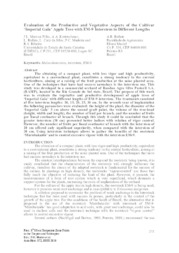Evaluation of the productive and vegetative aspects of the cultivar 'Imperial Gala' apple tree with EM-9 interstem in different lengths.
Evaluation of the productive and vegetative aspects of the cultivar 'Imperial Gala' apple tree with EM-9 interstem in different lengths.
Author(s): MARCON FILHO, J. L.; KRETZSCHMAR, A. A.; RUFATO, L.; SILVA, L. C. da; MADEIRA, F. C.; RIBEIRO, R. S.; RUFATO, A. de R.
Summary: The obtaining of a compact plant, with less vigor and high productivity, equivalent to a conventional plant, constitutes a strong tendency in the current horticulture, aiming at a raising of the fruit production at the same planted area. One of the techniques that have had success nowadays is the interstem use. This study was developed in a commercial orchard of Randon Agro Silvo Pastoril S.A. (RASIP), located in the Rio Grande do Sul state, Brazil. The purpose of this work was to evaluate the vegetative and productive development of apple trees of 'Imperial Gala' with different lengths of EM-9 interstem. The treatments consisted of five interstem lengths: 10, 15, 20, 25, 30 cm. In the seventh year of implantation the following parameters were evaluated: the height of the plant, the diameter of the 'Imperial Gala' 5 cm above the second graft point, the volume of the tree-head (height, width and length), the number of bud per branch, and the number of fruits per lineal centimeter of branch. Through this study it could be concluded that the greater interstem (30 cm) presented better indices with relation of vigor control. However, the number of fruits per lineal centimeter of branch with the interstem of 10 cm offered only significant superiority, when compared with the interstem of 30 cm. Using interstem technique allows to gather the benefits of the rootstock 'Marubakaido' and to control excessive vigour with the interstem EM-9.
Publication year: 2010
Types of publication: Journal article
Unit: Embrapa Grape & Wine
Keywords: Enxertia, Fruticultura, Haste, Maçã, Porta-enxerto
Observation
Some of Embrapa's publications are published as ePub files. To read them, use or download one of the following free software options to your computer or mobile device. Android: Google Play Books; IOS: iBooks; Windows and Linux: Calibre.
Access other publications
Access the Agricultural Research Database (BDPA) to consult Embrapa's full library collection and records.
Visit Embrapa Bookstore to purchase books and other publications sold by Embrapa.

